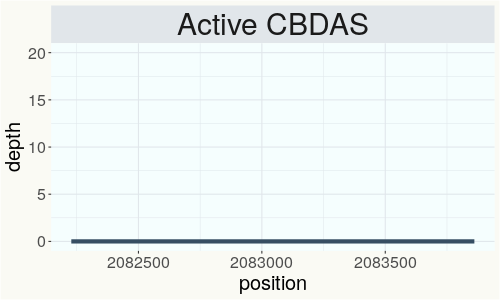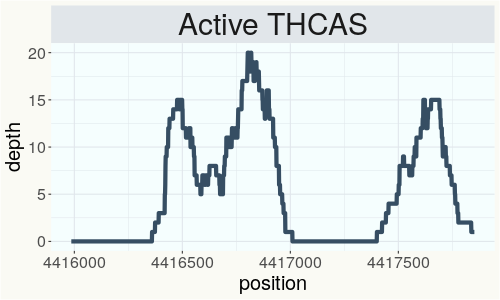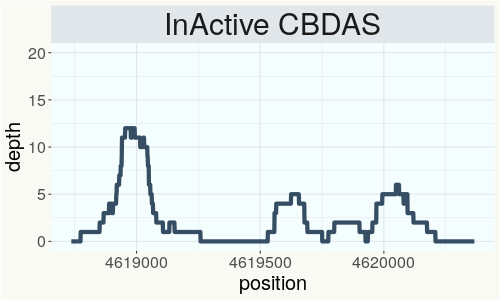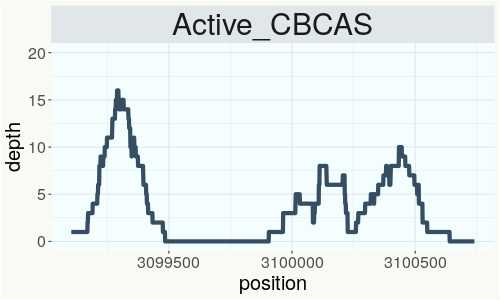Durban Poison #1
RSP 11013
Grower: DigiPath Labs
General Information
- Sample Name
- F20160801-04-15
- Accession Date
- September 17, 2017
- Reported Plant Sex
- Female
- Report Type
- StrainSEEK v2 3.2Mb
- DNA Extracted From
- Unknown
The strain rarity visualization shows how distant the strain is from the other cultivars in the Kannapedia database. The y-axis represents genetic distance, getting farther as you go up. The width of the visualization at any position along the y-axis shows how many strains there are in the database at that genetic distance. So, a common strain will have a more bottom-heavy shape, while uncommon and rare cultivars will have a visualization that is generally shifted towards the top.
Chemical Information
Cannabinoid and terpenoid information provided by the grower.
Cannabinoids
- THC + THCA
- 24.9%
- CBD + CBDA
- 0.056%
- THCV + THCVA
- 0.%
- CBC + CBCA
- 0.011%
- CBG + CBGA
- 1.031%
- CBN + CBNA
- 0.09%
Terpenoids
- α-Bisabolol
- 0.005%
- Borneol
- n/a
- Camphene
- 0.002%
- Carene
- 0.053%
- Caryophyllene oxide
- 0.004%
- β-Caryophyllene
- 0.099%
- Fenchol
- n/a
- Geraniol
- 0.016%
- α-Humulene
- 0.035%
- Limonene
- 0.071%
- Linalool
- 0.011%
- Myrcene
- 0.107%
- α-Phellandrene
- n/a
- Terpinolene
- 0.596%
- α-Terpineol
- n/a
- α-Terpinene
- 0.036%
- γ-Terpinene
- 0.71%
- Total Nerolidol
- 0.006%
- Total Ocimene
- 0.315%
- α-Pinene
- 0.049%
- β-Pinene
- 0.085%
Genetic Information
- Plant Type
- Type I
File Downloads
The bell curve in the heterozygosity visualization shows the distribution of heterozygosity levels for cannabis cultivars in the Kannapedia database. The green line shows where this particular strain fits within the distribution. Heterozygosity is associated with heterosis (aka hybrid vigor) but also leads to the production of more variable offspring. When plants have two genetically different parents, heterozygosity levels will be higher than if it has been inbred or backcrossed repeatedly.
The ratio of reads mapped to Y-contigs to reads mapped to the whole Cannabis genome (Y-ratios) has been demonstrated to be strongly correlated with plant sex typing. This plot shows the distribution of Y-ratios for all samples in our database which were sequenced with the same method (panel or WGS) as this sample and where this sample falls in the distribution.

This chart represents the Illumina sequence coverage over the Bt/Bd allele. These are the three regions in the cannabis genome that impact THCA, CBDA, CBGA production. Coverage over the Active CBDAS gene is highly correlated with Type II and Type III plants as described by Etienne de Meijer. Coverage over the THCA gene is highly correlated with Type I and Type II plants but is anti-correlated with Type III plants. Type I plants require coverage over the inactive CBDA loci and no coverage over the Active CBDA gene. Lack of coverage over the Active CBDA and Active THCA allele are presumed to be Type IV plants (CBGA dominant). While deletions of entire THCAS and CBDAS genes are the most common Bt:Bd alleles observed, it is possible to have plants with these genes where functional expression of the enzyme is disrupted by deactivating point mutations (Kojoma et al. 2006).



This chart represents the Illumina sequence coverage over the CBCA synthase gene.

Variants (THCAS, CBDAS, and CBCAS)
No variants to report
Variants (Select Genes of Interest)
| PKSG-2a | c.67T>A | p.Phe23Ile | missense variant | moderate | contig700 | 1945567 | A/T | |
| PKSG-2a | c.31A>T | p.Thr11Ser | missense variant | moderate | contig700 | 1945603 | T/A | |
| aPT4 | c.1168T>C | p.Tyr390His | missense variant | moderate | contig121 | 2833503 | T/C |
|
| aPT1 | c.629C>T | p.Thr210Ile | missense variant | moderate | contig121 | 2840237 | C/T | |
| HDS-2 |
c.82_93delGT |
p.Val28_Thr3 |
conservative inframe deletion | moderate | contig95 | 1989748 |
CGTAACCGGAAC |
|
Nearest genetic relatives (All Samples)
- 0.004 Durban Poison (RSP11226)
- 0.006 Durban Poison (RSP10998)
- 0.008 Durban Poison #1 (RSP10996)
- 0.008 Durban Poison (RSP11014)
- 0.123 Lift (RSP11378)
- 0.125 Domnesia (RSP11184)
- 0.129 Electra (RSP11366)
- 0.132 Black Jack (RSP10603)
- 0.138 Serious Happiness (RSP10763)
- 0.139 RKM-2018-016 (RSP11108)
- 0.140 BLACK JACK (RSP11346)
- 0.140 RKM-2018-025 (RSP11117)
- 0.145 Doug s Varin (RSP11243)
- 0.146 Joy (RSP11380)
- 0.148 Gold Cracker (RSP11048)
- 0.148 Whitey (RSP11363)
- 0.152 UnObtanium (RSP11611)
- 0.157 Lifter (RSP11365)
- 0.160 Suver Haze (RSP11364)
- 0.161 Trump x Trump (RSP11466)
Most genetically distant strains (All Samples)
- 0.413 80E (RSP11213)
- 0.388 Cherry Blossom (RSP11323)
- 0.385 80E (RSP11212)
- 0.378 80E (RSP11211)
- 0.373 JL yellow (RSP11075)
- 0.373 Feral (RSP10891)
- 0.368 R1in136 (SRR14708226)
- 0.366 Cherry Blossom (RSP11318)
- 0.361 Feral (RSP11205)
- 0.360 CS (RSP11208)
- 0.360 JL 3rd Gen Mother (RSP11214)
- 0.358 Feral (RSP10892)
- 0.357 Feral (RSP11206)
- 0.354 Beniko (SRR14708275)
- 0.354 GMO x Garlic Breath (RSP12507)
- 0.354 VIR 223 - Bernburgskaya Odnodomnaya - bm (SRR14708217)
- 0.353 R1in136 (SRR14708227)
- 0.352 Santhica 27 (SRR14708211)
- 0.351 Carmagnola (RSP11037)
- 0.351 R1in136 (SRR14708237)
Nearest genetic relative in Phylos dataset
- Overlapping SNPs:
- 68
- Concordance:
- 67
Nearest genetic relative in Lynch dataset
- Overlapping SNPs:
- 6
- Concordance:
- 6
Blockchain Registration Information
- Transaction ID
-
042179e973bd8732
d672517c8108ff73 541eb43d5b861794 9cf87ad1aa0429f7 - Stamping Certificate
- Download PDF (844.3 KB)
- SHASUM Hash
-
1b68f4b39dd03f70ed5c42be7143c391 b8ec36e3e817676b 95a5787c608d7720